Table of Contents
Blue-green algae (cyanobacteria) in the aquarium – slimy algae
Let's start with the first group of algae, the so-called blue-green algae. There are basically only a few other terms here apart from the name of the slimy algae. But as the scientific name cyanobacteria suggests, these are certain bacteria. Blue-green algae do not have a cell nucleus. Nevertheless, they have some distinctive features that allow them to be quickly distinguished from other types of algae.
Characteristics of construction algae:
- When touched, they usually have a lubricating film, hence the name smear algae
- green or brown coating covers the gravel or the leaves of the plants
- Coating can even be black and furnishings can also be infested
- foul smell
- rapid spread
As can be seen in the list, identifying this type of algae is quite simple. Basically, you can tell them apart from all other types of algae by their greasy consistency. Their distribution is also rather unusual due to the rapidity. It can appear overnight.
- Effectively combats all types of algae
- For prevention and quick action
- The ingredient is released immediately and ensures a quick effect
- Optimal distribution of active ingredients through liquid formula
- For all freshwater aquariums
- Contains 2,2 ', 2' '- (hexahydro-1,3,5-triazine-1,3,5-tryl) triethanol. Can cause allergic reactions.
- No water discoloration
- Contains intensive active ingredients against strong algae growth
- Emergency brake for very strong algae growth
The history of blue-green algae goes back a long way. The blue-green algae does not always have a negative function, because millions of years ago we owe our lives to the blue-green algae. Blue-green algae (cyanobacteria) also release oxygen through photosynthesis. The reason for life on our planet. In addition to light, growth drivers are also chlorophyll. Unfortunately, blue-green algae usually occur in extreme proportions. In lakes or open waters, one quickly speaks of an algal bloom. Here the blue-green algae (cyanobacteria) are the cause.
You can find out what you can do against blue-green algae and, above all, how to protect yourself against them in our next part, where we go into combating the individual species.
But one thing right away. A nutrient overload is usually to blame and there is also a fast one Remedy with the dark cure.
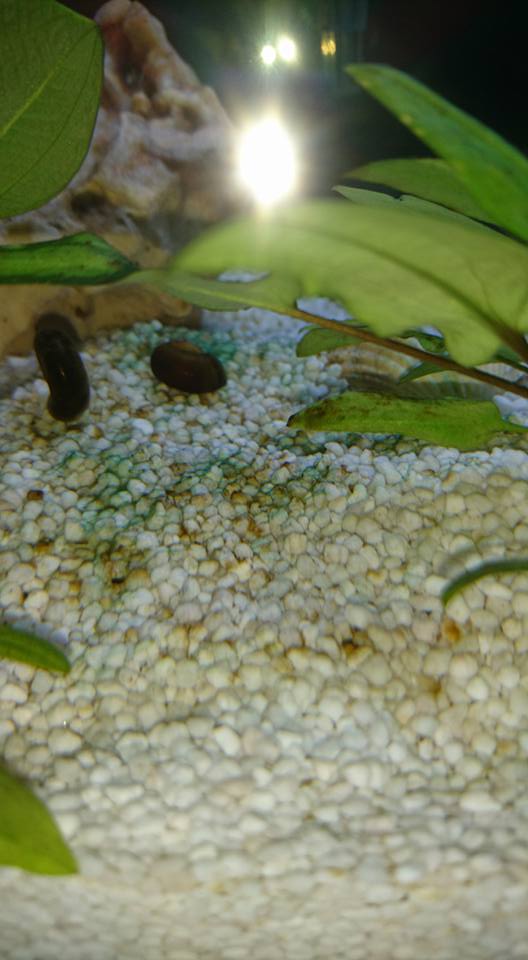
Green algae: filamentous algae, floating algae (chlorophyta) in the aquarium – lint algae, fur algae, hair algae, green dot algae and dust algae
As you can already see from the list, there are a lot of different types of green algae and most of them also look very different. That is why we have to treat the algae differently when determining them.
Algae in the aquarium: filamentous algae
Determining and recognizing thread algae is probably the easiest. It can be recognized by its many threads, which in the early stages usually start on furnishings. At a later stage, the threads can be found on almost anything in the pelvis. Be it on the roots or on the plants, filters, heating and also on hoses and pipes. The appearance is similar to a thread. Of course, the thread algae are almost always green and either feel very soft, or even harder and more tear-resistant in the advanced stage. This species can also reproduce very quickly. See also the following picture of a user from Aquafreaks on Facebook. Here you can see how bad such a thread algae plague can be.
Especially in the running-in phase you can observe the thread algae, which then usually go back on their own. But this only happens if you also use a proper planting.
Unfortunately, it has few predators, but mechanical removal is very easy. You can find out how it occurs and what you can do about it in the following guide.
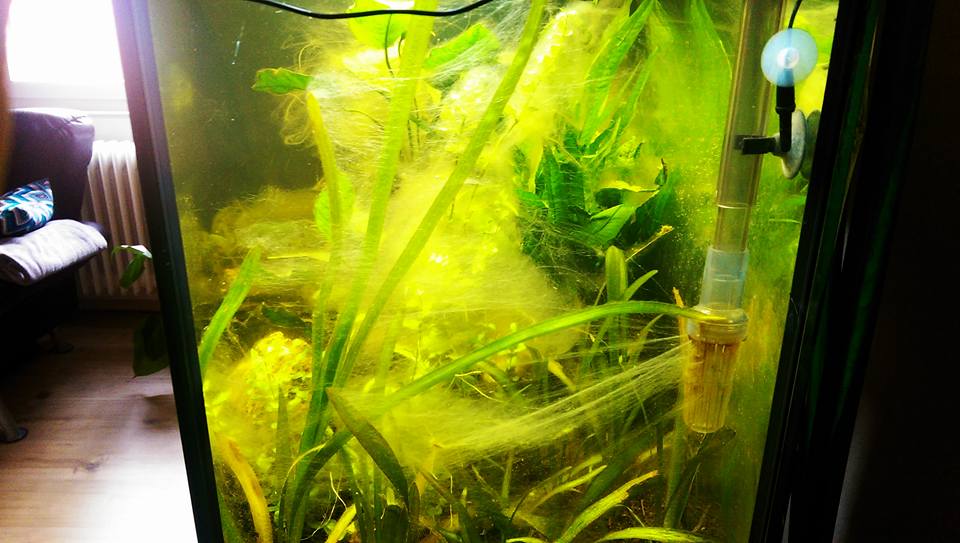
Algae in the aquarium: floating algae (Chlorophyta)
Floating algae (Chlorophyta) are also often referred to as an algal bloom. The reason for this is also the very rapid spread. The floating algae is also quite easy to recognize because it turns the water in the aquarium completely green. That is why it is also one of the green algae. The floating algae (chlorophyta) are created by the many spores of the algae. These spores then cause the cloudiness. The emergence usually has to do with a major change. Be it due to solar radiation or also by the wrong fertilization and the associated difference in nutrient balance. In addition, this type of algae is usually found in the running-in phase. Again, the initial lack of balance of nutrients triggered the cause.
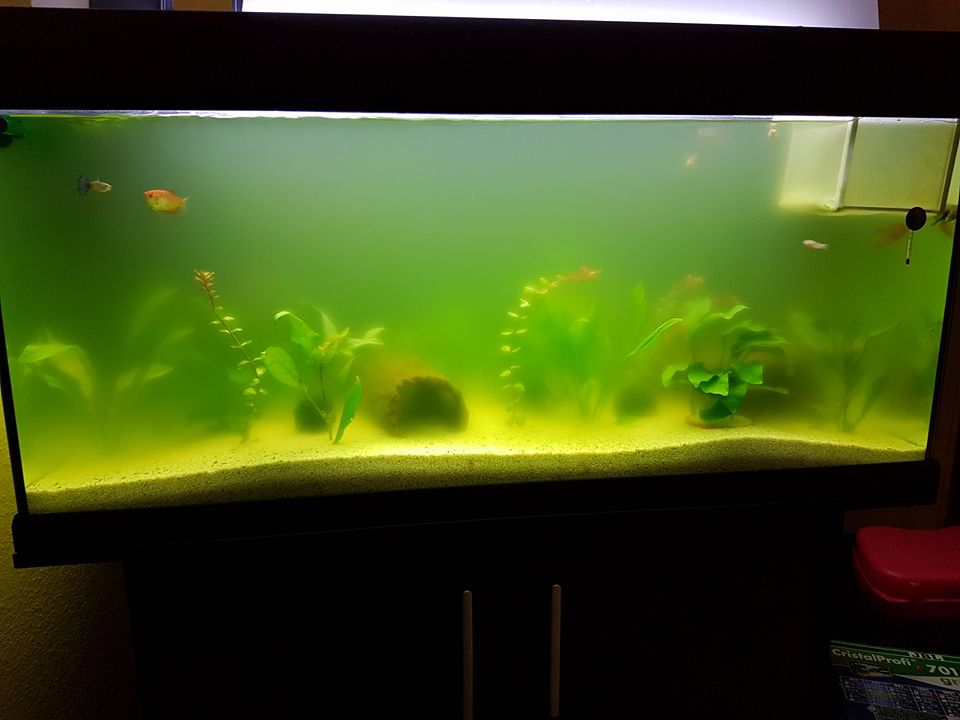
Algae in the aquarium: Lint algae, hair algae and fur algae
In the next group we have summarized three types of green algae because they look very similar and are difficult to tell apart. Some look more like fur and others have very small threads, which are nothing comparable to the extent of thread algae. Fur algae in particular can often be found in domestic aquariums. They like to cover stones and roots with a fine green fur, which can sometimes be very dense. If nothing is done about it, they can also form longer threads. Nevertheless, they can be distinguished quite well from the thread algae. Lint algae and hair algae are usually equated and are difficult to distinguish.
In the pictures you should be able to see what fur, hair and lint algae are. Here you can see the difference to the thread algae. However, combating it is quite simple. But more on that later.
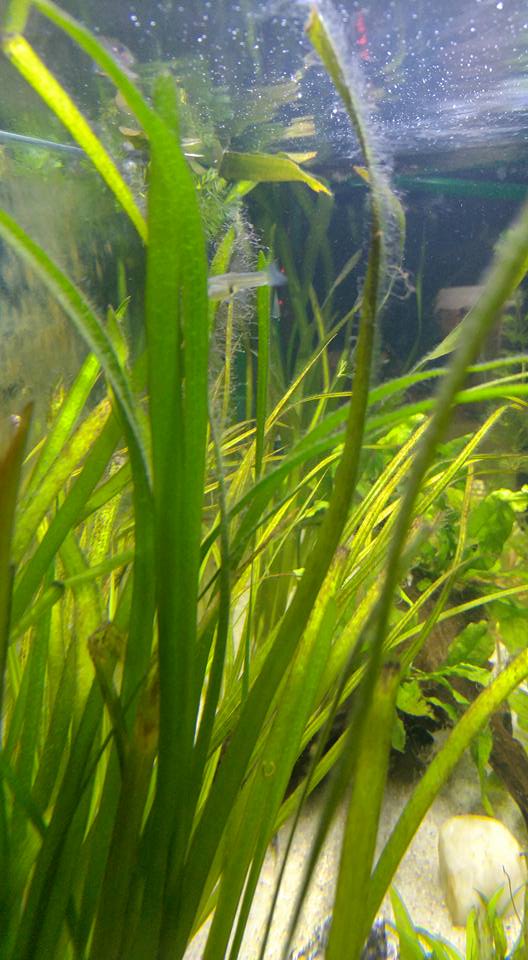
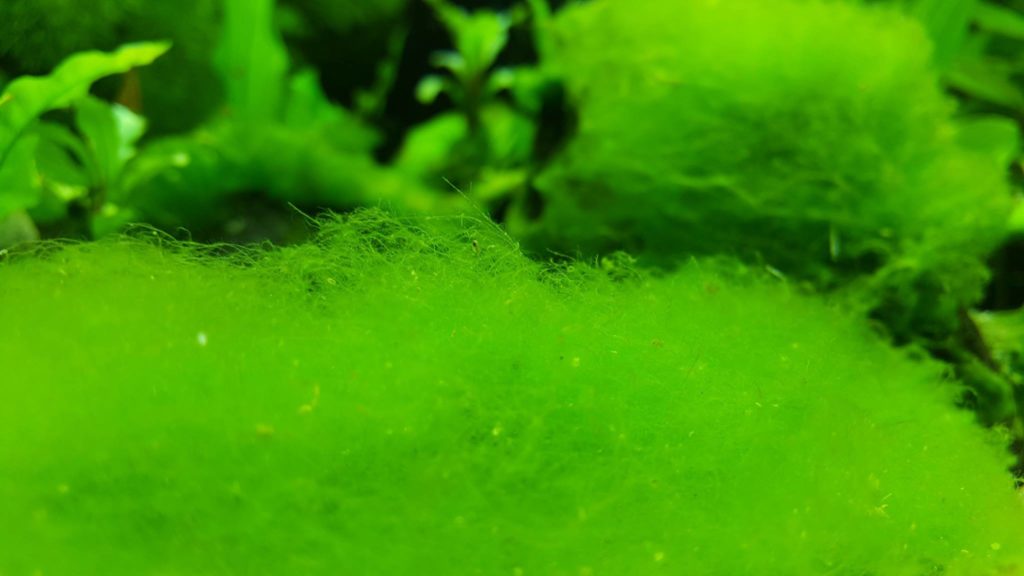
- Effectively combats all types of algae
- For prevention and quick action
- The ingredient is released immediately and ensures a quick effect
- Optimal distribution of active ingredients through liquid formula
- For all freshwater aquariums
- Contains 2,2 ', 2' '- (hexahydro-1,3,5-triazine-1,3,5-tryl) triethanol. Can cause allergic reactions.
- No water discoloration
- Contains intensive active ingredients against strong algae growth
- Emergency brake for very strong algae growth
Algae in the aquarium: spot algae
The green spot algae cause aquarists problems, especially on the panes. This type of algae particularly likes to settle there. As the name already suggests, this species consists of small, punctiform algae, which usually start out very small, but can then quickly become larger. First, you usually discover them on the panes of the aquarium, but before they can be seen on the furnishings. Even on large-leaved plants you can see the spot algae again and again. Determining and recognizing them can be difficult, because this species usually overlaps with others at the beginning. If you take beard algae, for example, then there can be a certain similarity. The origin and formation of these algae usually has something to do with the issue of nutrient imbalance. However, this species appears to be less common.
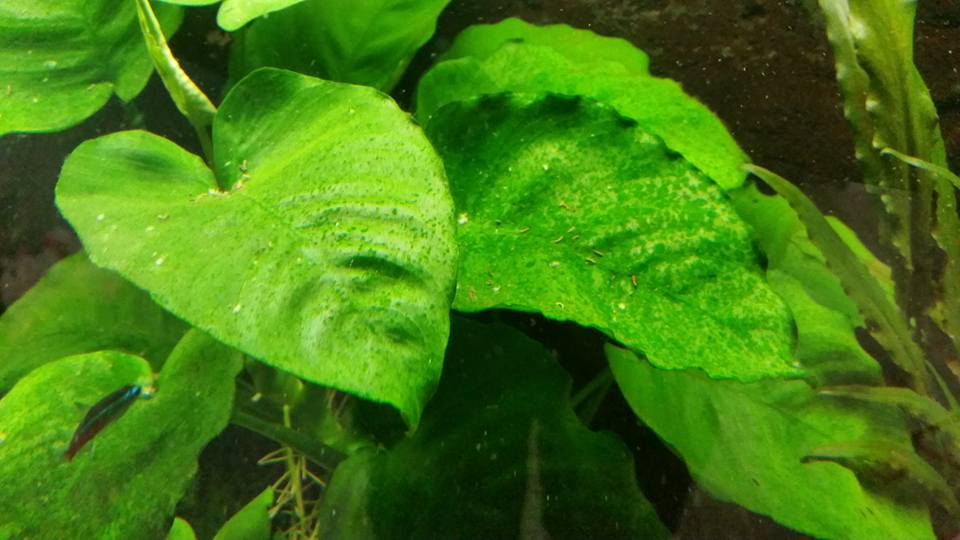
dust algae
Dust algae and floating algae are usually confused but are basically easy to tell apart. With the floating algae, the entire water turns green and the algae bloom occurs. There are almost no deposits there. This is different with dust algae. Usually a deposit develops here, which has a dust-like shape. You can find them very quickly on the windows, which is why this type is also called window plague. Compared to spot algae, dust algae can also be removed from the panes very quickly. They usually do not sit as firmly as the spot algae. There it may be that you cannot get by without a window scratch. These green algae deposits usually develop in just a few hours and multiply very quickly. It is currently also assumed that certain algae spores and microorganisms allow this type of algae to spread so quickly. Nevertheless, this dust algae does not pose a major problem, because it quickly disappears again.
Diatoms, brown algae (diatoms, bacillariophyta) in the aquarium
Let's now come to another group and leave the quite diverse type of green algae. The diatoms, also known as diatoms and bacillariophyta, form brown deposits, which can also cover everything in the aquarium. Be it the furnishings, or the plants and the aquarium panes. Due to their brown coloration, brown algae can often be read. The emergence of diatoms is usually quite typical and happens mainly in the start-up phase of an aquarium. There they can multiply quickly, as there is still little nitrate available. As soon as this increases, due to the conversion of nitrite, these algae usually disappear again quite quickly.
If you look at science, there are over 6000 genera and subspecies of diatoms. Diatoms are found not only in fresh water, but also in sea water. The diatoms are formed by cell division. In our second part on algae, we will explain how to get them out again.
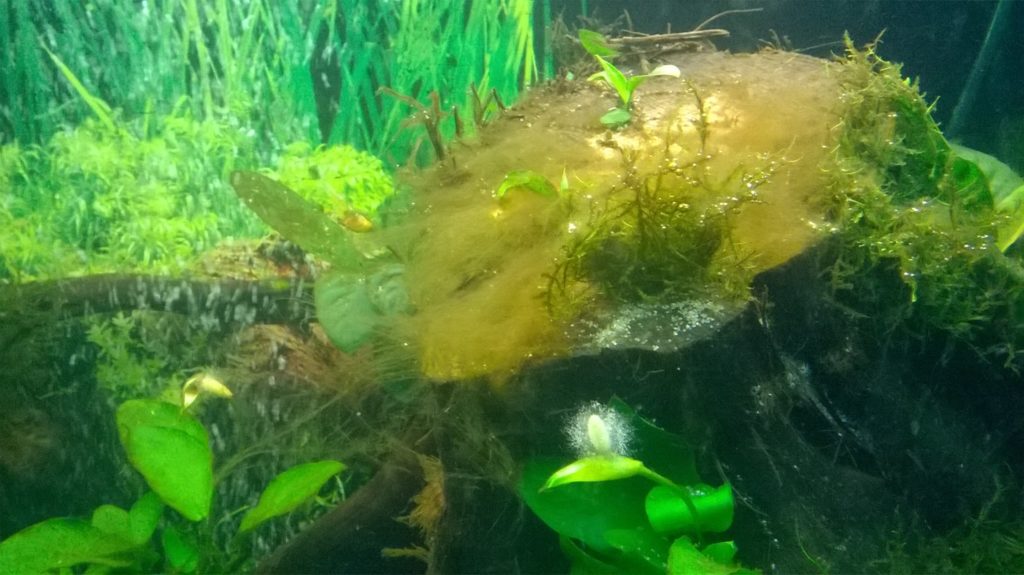
Red algae: beard algae, brush algae (Rhodophyta) in the aquarium
Let's come to the last group of algae. The red algae, which are mainly known under the names beard algae or brush algae. Red algae are mostly found in seawater, but they are also important in freshwater and in aquariums. The red algae also have a very large number of genera. Here you can register up to 5000. Here you can usually find them under the name of beard algae or brush algae. We will tell you how to best recognize them here.
Algae in the aquarium: brush algae (Rhodochorton)
Let's start with the determination with the brush algae. Here, too, the name already says a lot about the appearance. They can be recognized primarily by infesting the leaves of plants that grow slowly. There they settle at the edges. The color of the brush algae can range from green to brown and even black. However, they are not red. You can easily carry out a test to see if you have brush algae or beard algae.
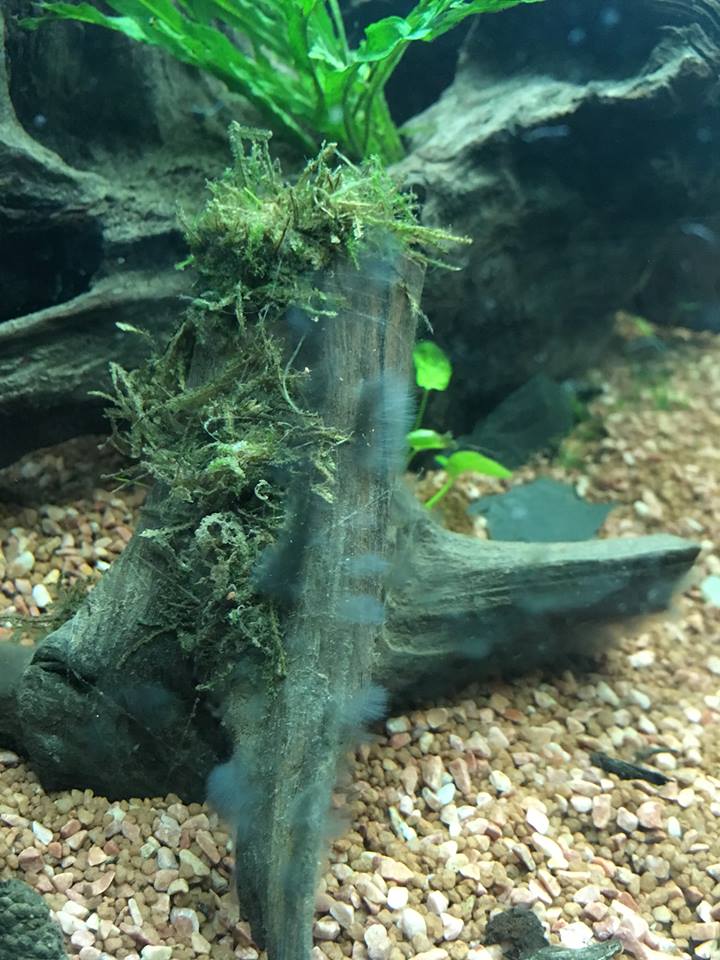
Algae in the aquarium: beard algae (Compsopogan)
Beard algae are very similar to brush algae or thread algae. Especially when both are still in the early stages. It is then difficult to distinguish the species from one another without a test. You can recognize them because later beard hairs develop. These can grow up to 10 cm long and usually settle on plants and furnishings.
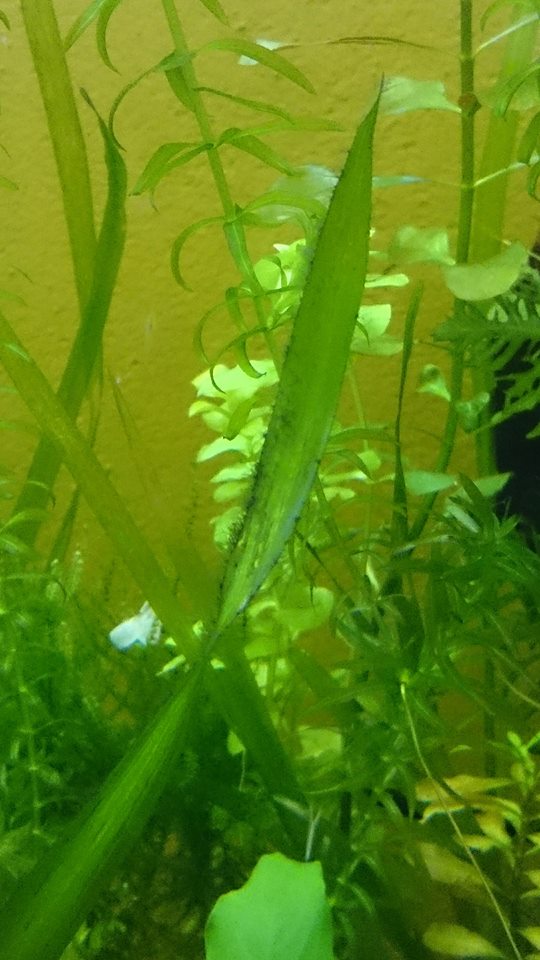
Im further articles we will then describehow to quickly get this type of algae under control. Here, too, is the magic word CO2 fertilization.
Our top seller and top list for algae control can be found here.
How do I fertilize properly with CO2
- Effectively combats all types of algae
- For prevention and quick action
- The ingredient is released immediately and ensures a quick effect
- Optimal distribution of active ingredients through liquid formula
- For all freshwater aquariums
- Contains 2,2 ', 2' '- (hexahydro-1,3,5-triazine-1,3,5-tryl) triethanol. Can cause allergic reactions.
- No water discoloration
- Contains intensive active ingredients against strong algae growth
- Emergency brake for very strong algae growth





